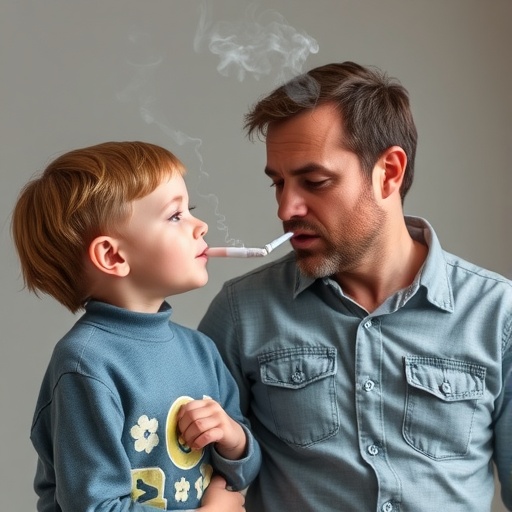PROTECT YOUR DNA WITH QUANTUM TECHNOLOGY
Orgo-Life the new way to the future Advertising by Adpathway
A groundbreaking study published in the esteemed respiratory journal Thorax has unveiled a disturbing new dimension of smoking-related harm—one that transcends an individual’s lifetime and affects subsequent generations. The research reveals that a father’s exposure to passive smoking during his own childhood can have a profound and lasting negative impact on the lung function of his children, thereby elevating their risk of developing chronic obstructive pulmonary disease (COPD). This intergenerational effect appears especially pronounced if those children were also passive smokers during their formative years, casting a dark shadow over public health that demands urgent attention.
COPD, a debilitating respiratory condition encompassing chronic bronchitis and emphysema, ranks as the third leading cause of death globally, claiming approximately 3 million lives each year. What has long been understood predominantly as a consequence of active smoking is now being viewed through a more complex lens, as researchers begin to decipher the intricate interplay of genetic, environmental, and behavioral factors—reaching back across generational lines. This study, leveraging data from the comprehensive Tasmanian Longitudinal Health Study (TAHS), intensifies the spotlight on passive smoking, implicating it as a hidden propagator of lung function decline across decades.
The TAHS cohort provided a rare and valuable dataset, following 8,022 children from childhood well into middle age, with serial lung function assessments performed via spirometry. Key lung function parameters investigated included forced expiratory volume in 1 second (FEV1) and forced vital capacity (FVC), both critical indicators in diagnosing and understanding obstructive lung diseases. Parental surveys conducted early and alongside follow-up evaluations gathered extensive information on respiratory health and environmental exposures, enabling a nuanced analysis of how early life factors shape pulmonary trajectories.
The researchers meticulously traced the lineage of smoke exposure by assessing fathers’ passive smoking status during two pivotal childhood windows: prepuberty (under 5 years) and up to 15 years of age. This definition hinged on whether the fathers’ own parents—i.e., the grandparents—smoked regularly around them. Intriguingly, over two-thirds of these fathers (approximately 69%) reported passive smoke exposure in their own youth, while more than half of their offspring had endured similar passive smoke exposure during their childhoods. This pattern of multi-generational exposure underscores the persistence of environmental smoke as a biological and social hazard carried forward within families.
Statistical analyses, controlling for crucial confounders such as the fathers’ history of asthma or wheezing and age, revealed that paternal childhood passive smoke exposure significantly elevated the odds of their children exhibiting below-average FEV1 values throughout life, a hallmark of impaired lung function. Specifically, these children had a 56% greater likelihood of reduced FEV1, though interestingly, FVC was not as notably affected. This selective vulnerability mirrors the pathophysiology of airway obstruction where airflow limitation predominates.
The study further demonstrated that paternal exposure to passive smoke in childhood was associated with a doubling of the risk that their offspring would exhibit an early and accelerated decline in the FEV1/FVC ratio, a clinical indicator often preceding overt COPD. While the elevated risk of COPD diagnosis in offspring by age 53 was also observed, this particular association diminished in statistical significance once other influential factors were considered. However, a particularly alarming synergy emerged: children whose fathers had been passive smokers prior to puberty and who themselves experienced passive smoke exposure during childhood were twice as likely to show compromised lung function (below average FEV1), suggesting compounding intergenerational effects.
Mechanistically, the research team proposed epigenetic modifications as a potential pathway underpinning these findings. The prepubertal period in boys—a critical window marked by growth and development—is particularly sensitive to environmental insults. Passive smoke exposure during this time may induce changes in gene expression and impair DNA repair mechanisms, effects which could be heritable. This idea aligns with emerging science indicating that environmental toxins can leave an epigenetic “footprint,†influencing phenotype beyond the exposed individual, thereby challenging traditional views of hereditary risk factors.
Importantly, the observed associations persisted even after accounting for smoking habits and respiratory illnesses in the fathers and their children. These factors only explained a minor fraction (less than 15%) of the lung function impairments witnessed, highlighting that passive smoke exposure is an independent and potent driver of impaired pulmonary outcomes. This points to an insidious and underappreciated hazard of tobacco smoke beyond direct smokers themselves.
As with all observational studies, the researchers caution against inferring direct causality. Limitations exist, including the absence of direct paternal lung function and genetic data that might illuminate familial aggregation effects or predisposing hereditary factors. Moreover, the operational definition of childhood passive smoke exposure—requiring at least one parent to have smoked six days a week—might have underestimated exposure levels by classifying lighter or moderate smokers as non-smokers, potentially diluting the strength of associations.
Nevertheless, these findings carry profound public health implications. Passive smoke exposure remains alarmingly high among adolescents globally, with estimates suggesting approximately 63% are affected, a stark contrast to the 7% who actively smoke. This disparity emphasizes the urgent need for societal and policy efforts to mitigate involuntary exposure—especially in homes and environments where children reside.
The study’s novelty lies in its pioneering focus on paternal prepubertal passive smoke exposure, rather than solely on active paternal smoking or maternal exposures, to explain impaired lung function in adult offspring. By unraveling this covert burden, the research underscores how environmental risk factors can echo through generations in subtle yet devastating ways. Public health messaging may need to shift accordingly, urging fathers and families at large not only to refrain from smoking themselves but also to create smoke-free environments that safeguard their children’s long-term respiratory health.
In conclusion, this research paints a cautionary tale of how the legacy of tobacco smoke can transcend a single individual’s experience, embedding itself in the biology of the next generation. Fathers exposed to tobacco smoke before puberty wield a hidden influence on their children’s pulmonary destiny, exacerbated when those children also endure passive smoke exposure. The pathway forward involves heightened awareness, stronger smoke-free policies, and a commitment to breaking this vicious cycle—so that future generations can breathe easier, free from the inherited shackles of smoke.
Subject of Research: People
Article Title: Paternal prepubertal passive smoke exposure is related to impaired lung function trajectories from childhood to middle age in their offspring
News Publication Date: 2-Sep-2025
Keywords: Respiratory disorders, Chronic obstructive pulmonary disease (COPD), Passive smoking, Lung function, Intergenerational health, Epigenetics, Public health
Tags: childhood exposure to tobacco smokechronic obstructive pulmonary disease statisticsCOPD risk factorsgenetic and environmental influences on lung healthimpact of childhood smoking exposureintergenerational effects of passive smokinglong-term effects of passive smokinglung health risks in childrenpublic health implications of smokingrespiratory health across generationssmoking-related health studiesTasmanian Longitudinal Health Study findings


 23 hours ago
6
23 hours ago
6





















 English (US) ·
English (US) ·  French (CA) ·
French (CA) ·